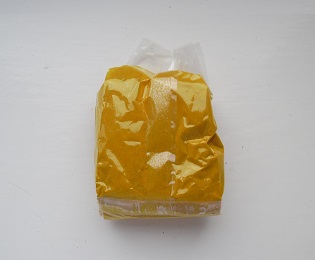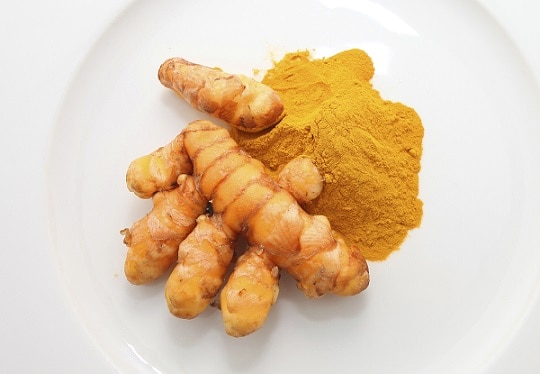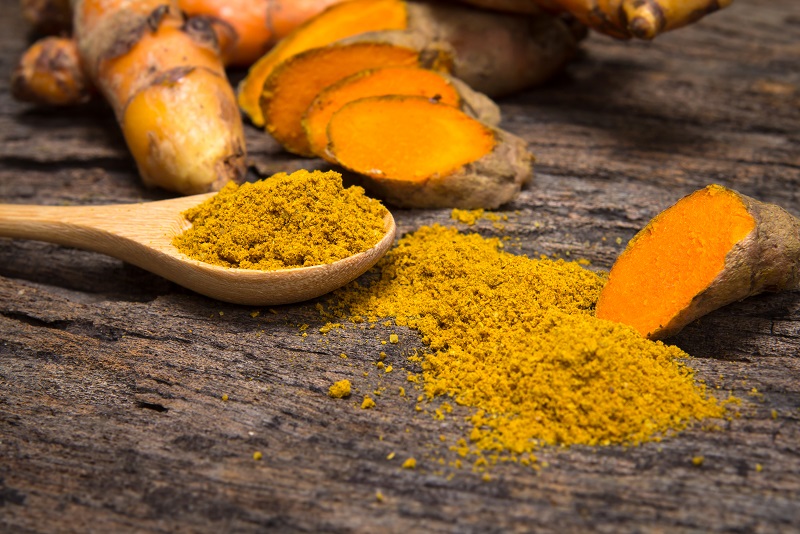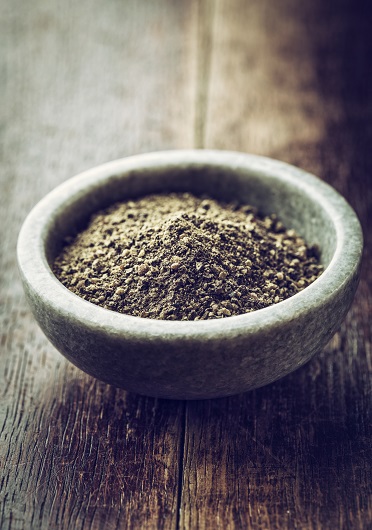Turmeric (curcuma longa) is a yellow coloured, culinary spice most famous as an ingredient in yellow mustard and fine Indian and Pakistani curries.
This spice belongs to the same family as ginger and has surfaced in the textbooks of Ayurvedic medicine for thousands of years. Evidence shows that turmeric trees were cultivated by the ancient Harrapan civilisations of 300BC, while ancient pots discovered near New Delhi contained turmeric, garlic, and ginger residues dating back as early as 2500BC.
Nowadays, India accounts for over 90% of global turmeric production. Approximately 30 varieties are recognised, with India’s most popular being ‘Alleppey Finger’, ‘Erode and Salem turmeric’, ‘Rajapore’ and ‘Sangli turmeric’, and ‘Nizamabad Bulb’.
This is the spice of 1000 uses, appearing in canned beverages, ice-cream, yoghurts, yellow cakes, biscuits, sweets, cake icings, baked products, dairy products, popcorn-colour, cereals, and sauces. It also has special cultural significance, as in India during wedding ceremonies, turmeric paste is rubbed into the bride and groom’s face and arms. Beauty is another story entirely, as turmeric paste is India’s go-to for enriching the skin’s complexion.
The Indians are in love with turmeric, especially in food…
…and there’s one other fact that might interest you. While the Indian middle classes are just as overweight and diabetic as more developed countries, their cancer rates are oddly low.
Prostate cancer, for example, is 23 times more common in American men than Indian men. Americans suffer from 10 to 11 times more colorectal cancer, 9 times more endometrial cancer, 8 and 14 times the rate of melanoma, 7 to 17 times more lung cancer, 7 to 8 times more bladder cancer, 9 to 12 times more kidney cancer, and 5 times more breast cancer. A recent study aptly titled “Dietary turmeric potentially reduces the risk of cancer” concluded that turmeric was mainly responsible.
Turmeric is possibly the healthiest spice yet discovered, and as a food for clearing acne, its benefits are off the chart.
Eating turmeric = make more antioxidants!
Firstly, you need to understand the amazing acne compound of curcumin. Turmeric is special in that rather than basic vitamins and minerals, almost all of its immense acne power comes from its vast array of minor plant compounds, with the most important being curcuminoids and the volatile oils. The latter consists of numerous aromatic compounds with two in particular, tumerone and ar-tumerone, having decent medicinal powers.
Curcuminoids, meanwhile, are natural antioxidants that impart the yellow colour turmeric, which include monodemethoxycurcumin, bisdemethoxycurcumin, and most notably curcumin.
Read Annihilate Your Acne – get the ultimate diet and clear your acne permanently!
In short, curcumin is the main active medicine compound of turmeric. It accounts for 3-6% of turmeric by weight, and may affect up to 700 genes in the body, comparing respectably to vitamin D’s 2000. Curcumin has been studied far more extensively in recent years than turmeric itself, and there’s now a booming curcumin supplement industry.
Curcumin reportedly exhibits over 150 therapeutic activities in the body. It’s surely odds on that one will improve acne, and indeed, the first is boosting glutathione (GSH), the main self-manufactured antioxidant.
I strongly advise all acne patients to increase glutathione, not least because a fantastic study once detected 20% lower levels in acne-covered skin compared to clear skin. As for curcumin…
ONE: this 2008 review discovered that “curcumin has potential therapeutic value for neurodegenerative diseases involving GSH depletion-mediated oxidative stress”. That’s excellent news given that acne is a disease involving glutathione depletion. Glutathione levels rose while protein oxidative rates decreased, suggesting that free radicals were deactivated.
TWO: this 1992 study was even more impressive, as mice taking 250mg of curcumin every day experienced an 80% increase in liver glutathione levels after 15 days.
THREE: this 2001 study fed rats either a placebo or 90% concentration curcumin, and observed 16% higher liver glutathione levels in the curcumin rats. Furthermore, malondialdehyde fell in the colon by 36%, a biomarker used to measure lipid peroxides, the worst type of free radical for acne.
FOUR: in a 2001 study, supplementing rats with curcumin prevented a sharp decrease in glutathione caused by the heavy metal mercury (a villain of tuna and dental fillings). Curcumin also lowered lipid peroxides and many other free radicals. Here, yet another study found that curcumin stimulated glutathione production in the body.
Turmeric is packed with antioxidants itself
Boosting glutathione would be great by itself, but turmeric delivers a double whammy of acne-fighting power, as curcumin also has its own antioxidant functioning. This is joined by the antioxidants tumerone and ar-tumerone, and turmeric’s overall score on the ORAC antioxidant scale is a massive 127,069. A handful of blueberries scores 4669 and a plateful of broccoli scores 1510, which are already acclaimed by nonstop media articles as “superfoods” themselves.
Turmeric itself beings life as a root (see picture above), and is first boiled for 30-45 minutes. The root is then dried in a hot oven, before finally being ground into a deep orange-coloured power.
Because all the moisture is evaporated and the spare plant matter ground away, turmeric powder is an incredibly concentrated form of the root’s original nutrients. The strong woody flavour is a classic DIY indicator of this, since varying antioxidant profiles provide the varying flavours in plant foods.
This study analysed turmeric itself, and after a high daily intake among 30 volunteers aged 40-69, there was far less oxidation of HDL and LDL cholesterol after 60 days. Apparently, “the effect was quite striking” particularly in participants whose lipid peroxides (fat-based free radicals) were elevated to begin with.
That’s excellent news for clear skin obsessives worldwide, as while water-soluble antioxidants are important, fat soluble-ones are on a whole other level, as they prevent a pore-clogging compound called squalene peroxide from forming via the oil on your face. Judging by this study and this study, turmeric seems to protect against lipid peroxides preferentially.
Turmeric competes with anti-inflammatory drugs
Turmeric’s glutathione-boosting powers have been largely overlooked by the health community, but there’s no doubt that its most famous power is excellent for acne too. Turmeric, or more specifically curcumin, can lower chronic inflammation as effectively as non-steroidal anti-inflammatory drugs (NSIADs).
This was shown perfectly by a study on 45 rheumatoid arthritis patients, who took either 500mg of curcumin or the drug diclofenac sodium. The scientists said that “interestingly, the curcumin group showed the highest… improvement in overall Disease Activity Scores”, beating the pharmaceutical drug group with ease.
While arthritis and acne manifest themselves very differently, they share one important characteristic: being born in the fiery pits of chronic inflammation, AKA an overactive immune system. In arthritis, these inflammatory chemicals are chipping away at bones and joints, while with acne, they’re bombarding p.acnes bacteria until the surrounding pore swells up.
Tons of studies have confirmed curcumin’s anti-inflammatory powers, including this 2014 study testing 117 people with metabolic syndrome.
Recommended – the top 6 vitamins and minerals for acne-free skin
After 8 weeks, a group taking curcumin each day had significantly lower levels of c-reactive protein than the placebo group, the main bodily biomarker of inflammation. Two other inflammatory biomarkers also fell, and while they were at it, the scientists reviewed 8 previous studies and concluded that curcumin was the nemesis of CRP.
The overall conclusion? “Short-term supplementation with curcuminoid-piperine combination significantly improves… inflammatory status in patients with MetS.”
The mechanism was very interesting, as rather than deactivating individual inflammatory chemicals behind acne such as interleukin-6 or IL-8, turmeric downregulated the inflammatory process at its root by lowering NF-Kappa (study, study). That’s a master molecule controlling a vast swathe of smaller inflammatory chemicals, which doctors frequently target themselves using pharmaceutical drugs.
It doesn’t end there for turmeric!
This yellow Indian spice seems to affect more factors behind acne than any other food, including reducing the secretion of cortisol (study). That’s the main stress hormone in humans, which unleashes acne via digestive problems, delayed wound healing, and increased insulin.
Turmeric contains trace minerals as well, including 26% of the RDI for manganese, 3% for magnesium, and 3% for vitamin C. This study found potent antidepressant activity in curcumin, increasing the “happiness hormone” serotonin in mice, which should counteract stress hormones further. The glutathione study above found strong defensive powers against mercury, the toxic heavy metal which contributes to acne via inflammation and increasing insulin.
Why using raw honey could revolutionise your skin
Speaking of insulin, one curcumin study was conducted on prediabetic volunteers, people right on the precipice of developing type 2 diabetes.
One group swallowed 6 curcumin pills per day, and after 9 months, none of them developed type 2 diabetes, compared to 16.4% of the placebo group. The curcumin had a 100% success rate, and the reason was identified: greatly improved functioning of insulin receptor cells.
That’s music to the ears of acne patients, because when energy stores are more receptive, your body requires less insulin to store glucose in them. This allows bloodstream insulin to fall, and because insulin stimulates your sebaceous glands to pump out more sebum (oil), your skin becomes less oily. Boosting insulin sensitivity is a top priority of all acne patients, and a separate Japanese study has reconfirmed the powers of turmeric.
Turmeric sharpens up your brain

Eating turmeric won’t just give you amazing skin, and it won’t just prevent diseases like cancer. Turmeric may also supercharge your brain power and mental capabilities by increasing neuron generation.
For decades, it was believed that once your brain had finished developing by about age 25, your neurons were done multiplying. They could no longer regenerate and if you abused them through alcohol or drugs or poor eating, your mind was basically a goner.
However, it now turns out that neurons form new connections all throughout adulthood. In certain areas of the brain, they can also increase in number.
One caveat is that this continued division and multiplication is strongly influenced by your lifestyle. Sugar, for example, depresses your brain-derived neurotropic factor (BDNF) levels, the protein which kickstarts neuron generation…
…but our old friend turmeric powder has been shown to increase DNF activity, according to this and this study. This study confirmed that feeding curcumin to rats increased the multiplication of cells in their hippocampus (potentially turning them into superrats).
BDNF holds the keys to memory, intelligence, special awareness, inventiveness, and sensorial sharpness.
Then there’s Alzheimer’s, another disease on curcumins’ rapidly growing hitlist. Alzheimer’s is extremely complicated, but it often develops when protein fragments called amyloid-B accumulate and form hard plaques between neurons.
An amyloid is a general term for healthy protein fragments which the body produces, while amyloid-B is a more specific fragment snipped from a whole protein called amyloid precursor protein (APP). In a healthy brain, these proteins fragments are broken down and eliminated with no harm done. But in Alzheimer’s disease, the clearance malfunctions. The fragments form hard, insoluble plaques which only accumulate overtime.
In a pair of studies published in April 2006 and December 2004, researchers discovered that curcumin could inhibit this feared amyloid-B aggregation, and dissolve amyloid fibrils more effectively than anti-inflammatory drugs such as ibuprofen and naproxen.
Better yet, tests on mice revealed that curcumin could cross the brain-blood barrier. Curcumin destroyed the ability of amyloid-B protein fragments to clump together, and halted further growth of the plaques.
Hence, curcumin might well delay the symptoms of Alzheimer’s such as mental confusion, forgetfulness and impaired mental function. A preliminary study also found that curcumin supercharged the specific immune system actors that destroy these evil plaques.
The top 7 topical treatments for clearing acne naturally
This isn’t just a pile of test tube gobbledegook either. Apparently, India has lower levels of Alzheimer’s than anywhere else in the world, particularly a village in northern India called Ballabgarh where the men live to their 70s yet barely show traces of Alzheimer’s.
According to this BBC article: “scientists believe recorded rates of the condition in this small community are lower than anywhere else in the world”. After testing 5000 villagers, the rates of Alzheimer’s were less than one third of the UK’s. The cultural obsession with turmeric has to be why.
Your expert’s guide to using turmeric
No matter how promising turmeric looks for clearing acne, you have to follow one hidden secret or your attempt will fail miserably.
Curcumin, the main bioactive component of turmeric, is very poorly absorbed in the human intestine. It simply passes through untouched, without impacting bloodstream levels, and is rapidly excreted from the human body.
That’s why you should follow another storied Indian tradition: combining all dishes with turmeric with a generous sprinkling of black pepper. Put simply, black pepper contains a compound called piperine which massively enhances the absorption of nutrients.
One study found that administering curcumin to humans increased bloodstream levels by very low or undetectable amounts, but that adding piperine led to miraculous improvements beginning 0.25 to 1 hour after administration. The curcumin became 2000% more bioavailable.
That’s why you should either 1) take a piperine supplement, since piperine also enhances magnesium, protein, and other antioxidants, or 2) always eat your curry with black pepper. One smart idea is to always swallow a few whole peppercorns before any meal containing turmeric. If you want a piperine supplement, then take the industry standard, which is Source Naturals Bioperine Extract. Fat is another curcumin absorption booster, so your new best friend should be butter.
As for turmeric overall, you can either feast on whole turmeric, whether in pills or meals, or you can take a dedicated curcumin supplement (with dozens now filling the market).
Combining the two is the ultimate solution, but if the pricetag is out of reach, then I would advise sticking to whole turmeric. Why? Because the spice has been featured in Indian medicine for thousands of years. It is partially responsible for the continued health of India today, yet the Indians of 2000BC certainly weren’t popping curcumin pills. Curcumin is terrific for acne, but turmeric contains dozens of subtler antioxidants and phytonutrients.
It’s often claimed that the concentrations of curcumin in turmeric are insufficient to have any benefit (3-6% by weight). Yet in studies, turmeric still reduces lipid peroxides and sharpens brain health just as effectively as isolated curcumin. You just absolutely have to remember the black pepper, as recommended by the ancient Ayurvedic School of Medicine.
Vitamin E – the ultimate nutrient for clogged pores
If you want a turmeric supplement, then you should always buy one with standardised curcumin levels. This ORGANIC INDIA Natural Turmeric Root fits the bill, and is completely free from inflammatory fillers, binders, and soy. The only extra ingredient is the vegetable pullulan capsule, and its curcumin concentrations are higher than similarly priced supplements.
There’s only one reason to avoid turmeric completely: if you have kidney stones.
Compared to other spices, turmeric is very high in oxalates, organic acids which form crystal complexes with calcium, which slowly build up to finally achieve kidney stone glory. Doctors advise kidney stone patients to avoid oxalates, and this study revealed that eating turmeric regularly led to urinary levels of oxalates roughly 5 times higher than cinnamon. They concluded that: “supplemental doses of turmeric, but not cinnamon, can significantly increase urinary oxalate levels, thereby increasing risk of kidney stone formation in susceptible individuals”
For the average Joe, however, turmeric is more likely to turn you into superman then leave you rolling in agony.
The verdict
In this article, I raved about cinnamon’s extraordinary power to lower insulin levels and blood sugar, and deemed it to be a top-notch acne-clearing spice. However, turmeric surpasses it with ease, affecting not only insulin, but antioxidants, inflammation, and acne-causing stress hormones.
Turmeric is among the most anti-inflammatory foods of all time. Meanwhile, chronic inflammation is the root cause of acne. There’s no higher recommendation than that.
NEXT: get the complete strategy for clearing acne naturally
Thanks for reading!



Any tips/thoughts on how we could incorporate turmeric into every day cooking apart from curry? For some reason I am not yet convinced by the efficacy of the supplemental form. Cheers